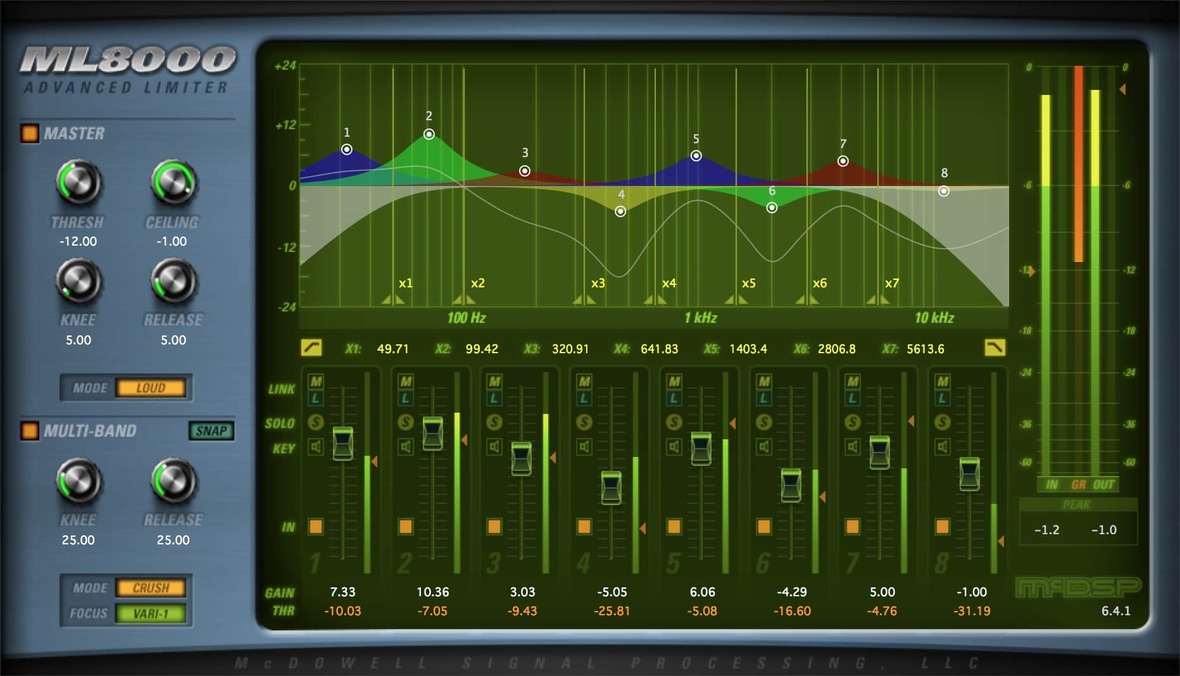
Review by Russell Cottier
Silicon Valley plug-in boffins McDSP cite ML8000 as the next generation in advanced limiting technology. The ML8000 plug-in features two discrete processors. The first being multistage, multi-band lookahead peak detection and limiting, followed by a broadband master limiter with some rather flexible controls. The ML8000 is based around similar calibration and algorithms to McDSP’s previous plug-in ML4000 but it seems to focus slightly more on limiting in the multi-band stage, rather than general dynamics processing. However we will come back to this in a moment because not all is as it seems.
As we look at the GUI it appears very much a classic McDSP plug-in, with a glowing green screen taking up much of the real-estate, this is surrounded by a frame with a blue brushed metal look, bringing to mind some kind of 1960s analogue oscilloscope feel. The left side of the plug-in offers controls for both limiter stages though one curious choice is that the master limiter controls sit above the multi-band controls section, suggesting that processing is reversed from the actual signal flow.
Following the signal flow, the multi-band section at the bottom of the left panel offers a bypass control in the form of an orange square. There are dials for knee and release which allow a good degree of fine tuning though these are global for the multi-band not per-band.
The main area of the plug-in offers a large graphical frequency plot showing all of the information and controls that you need to operate the multi-band limiter. With +/-24 dB gain for each of eight bands the ML8000 is a versatile and flexible processor allowing it to be used as EQ and dynamics for individual tracks in the mix, or something more gentle on a group bus, stereo bus or for mastering applications.
The eight frequency bands can be adjusted by dragging the vertical separators on the graphical plot or simply clicking the numerical read out below and typing in the relevant number. Bands tend to want to be at least one octave apart so moving one frequency separator may cause other bands to move. Initially this was frustrating when trying to sculpt very specific sounds, however the end results of this were actually quite effective. Embracing this feature proved the most prudent approach. High-pass and low-pass filters can be activated by clicking the icons in the graphical display, these are fixed slope and the start frequency follows bands one and eight. Perhaps the rolloff is a little shallow for something like a drum buss, where one might want to remove subs without infringing on the low bass frequencies, but in general use they are effective.
Less phase shift
Beneath the graphical display there are eight faders each with buttons for Master and Link modes, Solo, Key and Bypass. It’s interesting to note that McDSP claim the active processing they use, instead of conventional crossover algorithms, leads to less phase shift. Threshold is adjusted by clicking and dragging the small orange triangle next to the level meter for each band. Link mode can be selected to allow the bands to follow the threshold of whichever band is assigned as master. This allows the limiter to be pushed in globally. To be honest, far more ergonomic implementations of this have been developed in other plug-ins, but this annoyance is not a major workflow killer.
To the very right is the metering section which displays a simple peak meter for the input to the master limiter (output from the multi-band) a Gain Reduction meter and an Output meter. Threshold for the master limiter can be accessed via the small orange triangle adjacent to the input meter, likewise output Ceiling can be set with the orange triangle marker on the master output meter.
As one would expect Knee and Release allow the mastering limiter and multi-band limiter to behave somewhat more like compressors taking you from a very hard limiting with 0 Knee and 1mS Release, right through to softer settings that can sound somewhat vintage, allowing more gentle and even pumping effects.
Both limiters offer six modes: Clean, Soft, Smart, Dynamic, Loud and finally Crush. Obviously the choice of mode very much depends upon the parameters being used and the program material but Clean, Smart and Dynamic seemed to offer the most natural and transparent sound. Dynamic keeps the limiter breathing but not sucking. The multi-band limiter also has three focus modes, Fixed, Vari-1 and Vari-2. It’s difficult to put your finger on exactly what these do but they seem to change how each band is tracked and hence how gain reduction applied.
Overall the ML8000 is an incredibly versatile processor. It can be used in many different scenarios and offers clean, relatively artefact-free operation, even when moderate or heavy limiting is being applied. ML8000 excels on group vocals, modern aggressive drums and of course as a master bus processor or mastering limiter. At $129 for the Native version and $229 for HD ML8000 faces competition from other major brands, but McDSP offer a flavour of plug-in that is just a little unusual, and with a number of bundle deals on offer, you might just find this suits your studio perfectly.



